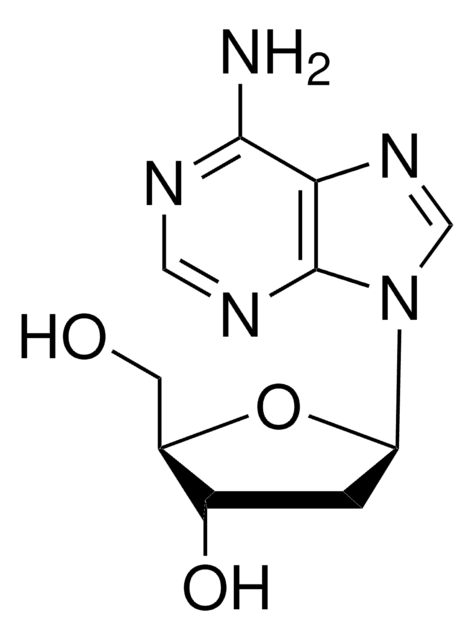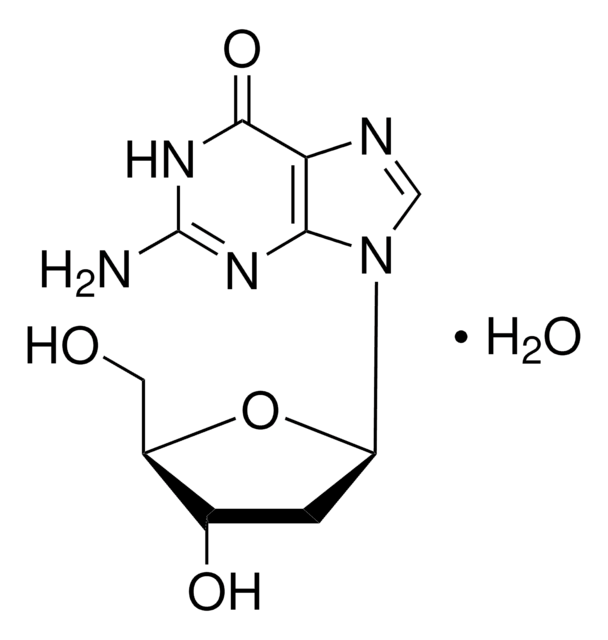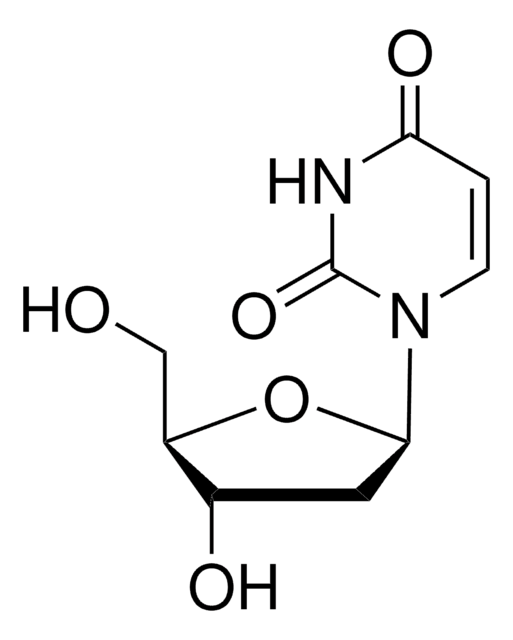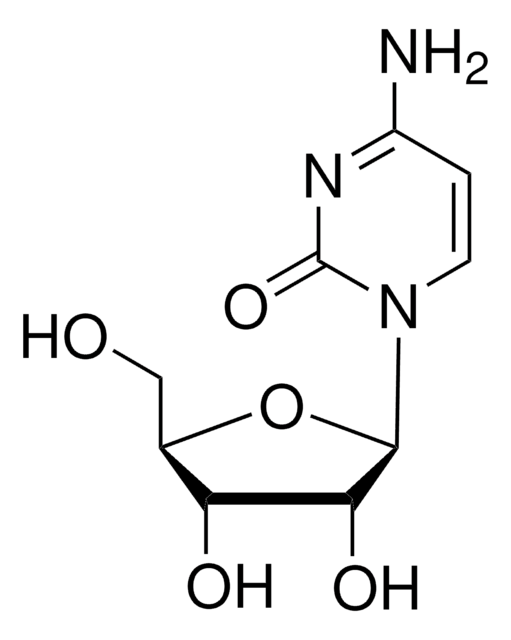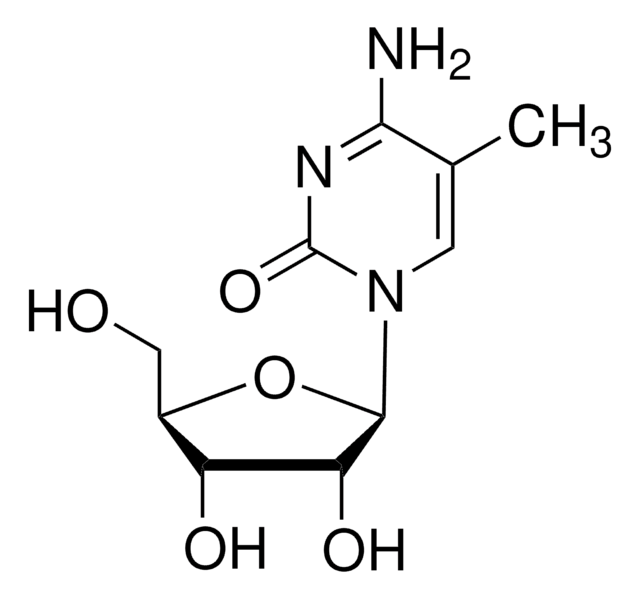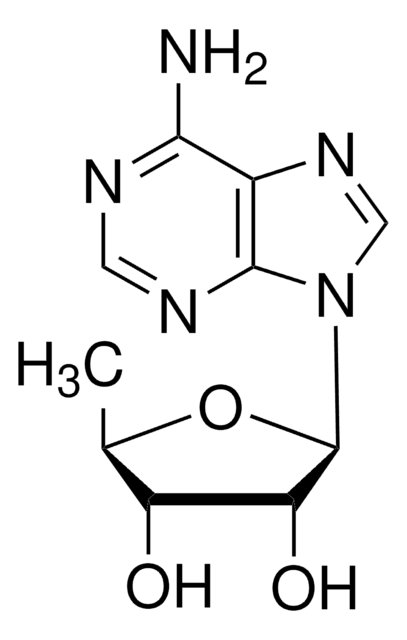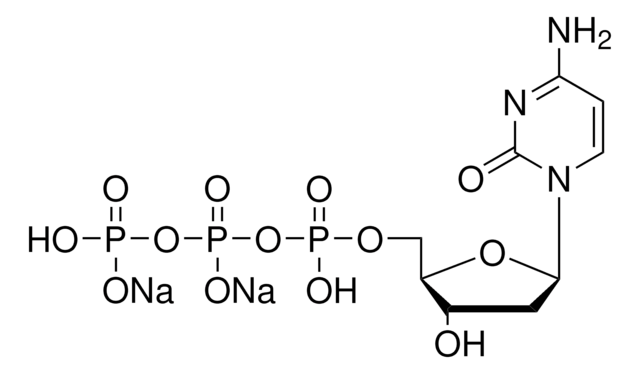おすすめの製品
由来生物
synthetic (organic)
アッセイ
≥99% (HPLC)
フォーム
powder
溶解性
water: 50 mg/mL, clear, colorless to very faintly yellow
保管温度
−20°C
SMILES記法
NC1=NC(=O)N(C=C1)[C@H]2C[C@H](O)[C@@H](CO)O2
InChI
1S/C9H13N3O4/c10-7-1-2-12(9(15)11-7)8-3-5(14)6(4-13)16-8/h1-2,5-6,8,13-14H,3-4H2,(H2,10,11,15)/t5-,6+,8+/m0/s1
InChI Key
CKTSBUTUHBMZGZ-SHYZEUOFSA-N
詳細
2′-デオキシシチジン(deoxyC)は、ヌクレオ塩基としてシトシンを含有するデオキシヌクレオシドの一種です。血液、糞便、および尿中に認められます。
アプリケーション
2′-デオキシシチジンは、以下の用途に使用されています:
- Trypanosoma bruceiシチジンデアミナーゼ(TbCDA)の基質として、その活性を測定するため
- 液体クロマトグラフィー-質量分析法(LC-MS)によりマウス腫瘍間質液中の代謝物の分離および定量における標準物質として
- 腫瘍遺伝子およびDNA複製ストレスに反応した自食作用の役割を検討するため
生物化学的/生理学的作用
2′-デオキシシチジン(deoxyC)はリン酸化によりdCTPを生成し、これがDNAポリメラーゼまたは逆転写酵素によるDNA合成に使われます。DeoxyCはデオキシシチジンデアミナーゼ(EC 3.5.4.14)の基質であり、これにより2′-デオキシウリジンに変換されます。DeoxyCは、酵素デオキシシチジンキナーゼ(DCK)によりヌクレオチドdCMPにリン酸化されます。DeoxyCは、潜在的頭頚部癌マーカーとして機能します。
保管分類コード
11 - Combustible Solids
WGK
WGK 3
引火点(°F)
Not applicable
引火点(℃)
Not applicable
個人用保護具 (PPE)
Eyeshields, Gloves, type N95 (US)
適用法令
試験研究用途を考慮した関連法令を主に挙げております。化学物質以外については、一部の情報のみ提供しています。 製品を安全かつ合法的に使用することは、使用者の義務です。最新情報により修正される場合があります。WEBの反映には時間を要することがあるため、適宜SDSをご参照ください。
Jan Code
D3897-BULK:
D3897-25G:
D3897-VAR:
D3897-100MG:
D3897-250MG:
D3897-1G:
D3897-500MG:
D3897-5G:
この製品を見ている人はこちらもチェック
Hiroya Murakami et al.
Talanta, 177, 12-17 (2017-11-08)
Acetaldehyde (AA), which is present in tobacco smoke, automobile exhaust gases and alcohol beverage, is a mutagen and carcinogen. AA reacts with 2'-deoxyguanosine (dG) in DNA to form N
Martyna Modrzejewska et al.
Free radical biology & medicine, 101, 378-383 (2016-11-12)
The most plausible mechanism behind active demethylation of 5-methylcytosine involves TET proteins which participate in oxidation of 5-methylcytosine to 5-hydroxymethylcytosine; the latter is further oxidized to 5-formylcytosine and 5-carboxycytosine. 5-Hydroxymethyluracil can be also generated from thymine in a TET-catalyzed process.
Annika R Seddon et al.
Epigenetics & chromatin, 14(1), 17-17 (2021-03-26)
Environmental factors, such as oxidative stress, have the potential to modify the epigenetic landscape of cells. We have previously shown that DNA methyltransferase (DNMT) activity can be inhibited by sublethal doses of hydrogen peroxide (H2O2). However, site-specific changes in DNA
Santiago Uribe-Lewis et al.
Genome biology, 16, 69-69 (2015-04-09)
The discovery of cytosine hydroxymethylation (5hmC) as a mechanism that potentially controls DNA methylation changes typical of neoplasia prompted us to investigate its behaviour in colon cancer. 5hmC is globally reduced in proliferating cells such as colon tumours and the
E Mini et al.
Annals of oncology : official journal of the European Society for Medical Oncology, 17 Suppl 5, v7-12 (2006-06-30)
Gemcitabine (2',2'-difluoro 2'-deoxycytidine, dFdC) is the most important cytidine analogue developed since cytosine arabinoside (Ara-C). The evidence of its potent antitumor activity in a wide spectrum of in vitro and in vivo tumor models has been successfully confirmed in the
ライフサイエンス、有機合成、材料科学、クロマトグラフィー、分析など、あらゆる分野の研究に経験のあるメンバーがおります。.
製品に関するお問い合わせはこちら(テクニカルサービス)